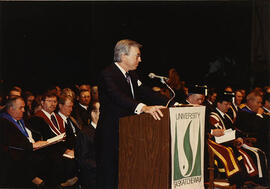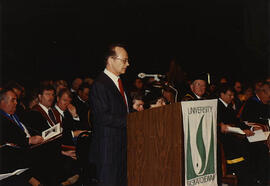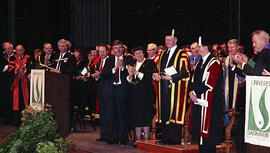Installation - President - Dr. George Ivany
- A-10431
- Item
- 3 Feb. 1990
Henry Dayday, Mayor of Saskatoon, speaks from podium at Convocation ceremony and Installation ceremony of Dr. George Ivany as Presidentheld at Centennial Auditorium.
Bio/Historical Note: Jesse William George Ivany was born in 1938 in Grand Falls, Newfoundland. He attended Memorial University of Newfoundland for a BSc in Chemistry and Physics, following which he completed a diploma in Education. He went on to Teachers College, Columbia University for an MA degree in Physics Education and to the University of Alberta for a PhD in Secondary Education. Dr. Ivany's alma mater, Memorial University of Newfoundland, conferred on him the degree of Doctor of Laws in 1990. From 1966-1974 he taught at Teacher's College, Columbia University, New York where he headed the Department of Science Education for two years. He also taught at the University of Alberta and at Prince of Wales College, St. John's, Newfoundland. In 1972-1973 he was visiting fellow, Institute of Education, University of London. Dr. Ivany was Dean of Education at Memorial University for three years before accepting a 1977 appointment as Dean of the faculty of Education at Simon Fraser University. From 1984-1989 he served as Academic Vice-President and Provost at Simon Fraser and was Acting President for six months during 1983. George Ivany served as the seventh President of the University of Saskatchewan from 1989-1999.






